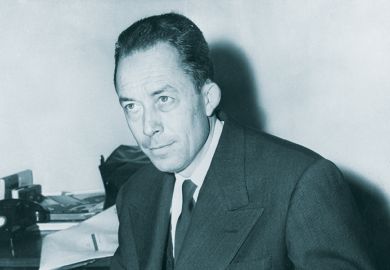I had not known the word pulviscular before reading Calvino. In the final chapter of If on a Winter's Night a Traveller , we encounter the thought that "reading is a discontinuous and fragmentary operation. Or rather, the object of reading is a punctiform and pulviscular material".
The speaker is the most strenuous of the seven wise readers gathered to advise you, the reader of this novel itself. A doomed obsessive, he pores over the tiniest particles of meaning, the "impalpable little granules" of which myths and mysteries consist, and through the space between which the truth of writing may be revealed - or escape.
The author of Our Mutual Friend would have recognised the monstrous allure of the pulviscular. (Calvino hails Dickens's novel as "an unqualified masterpiece" in one of the sharp little prefaces translated here for the first time, to Diderot's Jacques le Fataliste , Balzac's Ferragus , and Flaubert's Trois Contes , and perhaps more surprisingly, to James's Daisy Miller , Stevenson's The Pavilion on the Links , and Twain's The Man that Corrupted Hadleyburg .) So too would the Eliot who wrote of "fear in a handful of dust" and the Beckett whose Clov imagines "between my legs a little trail of black dust".
But Calvino's particles are less gravid than such traditional dust-to-dust. They whirl away in godless space, "a vortex of atoms floating in the void".
This last phrase is inspired by Stendhal, a prominent figure in Calvino's galaxy of classics, and the subject of one of the key pieces in this collection of 36 essays, of which 25 are published now for the first time in English. In "Knowledge as dust-cloud in Stendhal", (1980), Calvino describes the reality that his predecessor wishes to explore - and the present tense is revealing - as "punctiform, discontinuous, unstable, a pulviscular cloud of heterogeneous phenomena".
Most writers from the end of the Enlightenment onwards have flinched in the face of such seeming chaos, if not frankly abandoned the pursuit of knowledge. Calvino reserves his highest admiration for those like Stendhal, who have kept their cool and their passion for the human sciences, in pursuit of a "punctiform knowledge which connects the sublime with the infinitesimal, amour-passion with the marque de petite vérole ". No grand passion without the smallpox scar, then; no dazzling destiny without the minutest attention to detail.
Stendhal also figures in the earliest piece reprinted here, on Hemingway (1954). If Stendhal's heroes are caught at the intersection between 18th-century rationalist lucidity and Romantic Sturm und Drang , then a century later, Calvino argues, Hemingway's are at a similar crossroads. Save that the contrary currents that met in Stendhal have deepened their antagonism: "from the old Enlightenment trunk American technicist philosophies branch off, while the Romantic trunk brings forth its final fruits in existential nihilism". Hence the cult of technique, the dry, precise execution of tasks, exemplified by Hemingway's heroes and his own writing style; hence also, bereft now of Stendhal's Romantic excitement, the horror vacui of existential nothingness.
The Hemingway piece belongs to a group of four from the 1950s, the others being on Defoe, Conrad and Pasternak. These give us a strong sense of their author's political and intellectual position in the decade following his first published novel, The Path to the Spiders' Nests (1947). There is much talk about crucial moments in bourgeois thought, about the estrangement from history in Pasternak, about the definition of the self through work.
The style of commitment changes by the time we reach the essays of the 1970s and 1980s (there is little from the 1960s), but one can trace the continuities. As for instance in his respect for Voltaire's famous words about cultivating our garden, which concludes a brilliant account of Candide 's narrative rapidity (1974).
The maxim is now bound to sound laden with bourgeois complacency. But Calvino urges that we understand the force of its first formulation, 30 years before the fall of the Bastille, at a point in history when it heralds the rejection of metaphysics and a radical new commitment to working the earth beneath our feet.
Admirers of his own dazzling fiction will be most drawn to the pieces here in which Calvino points to his kith and kin. Among the 14 ways of regarding "the classics" in the title essay, the idea of personal encounter predominates. No matter if it involves disagreement or enmity: what is classic for you helps you know who you are, where you are, in relation or even opposition to it. Seek no longer the monument in which the classics are already gathered together, as once they were for the young Leopardi. We must each construct own ideal library out of the scattered particles. Forget about duty or respect; we should only read the classics for love.
Calvino rarely writes here out of less than love, or at least shrewd affection and intimate knowledge: for Xenophon and Pliny, for the Gerolamo Cardano whose De Consolatione is surely the book that Hamlet is reading, for Cyrano, Voltaire and Diderot, for Carlo Emilio Gadda, Eugenio Montale and Cesare Pavese. His predilections run instinctively to narrative, and the possibilities it harbours for a knowledge half-shared with the human and natural sciences.
He calls Montale, one of the few poets to attract his attention, "the poet of exactness". His own exact reading of Forse un Mattino Andando gives rise to an ingenious passage on the revolutionary invention of the rear-view mirror. It is not the automobile that gives motorised man his claim to be thought of as a new species, but the mirror which enables him to look before and after without seeing himself.
The half-dozen figures that make up his nearest and dearest are Ovid, Ariosto, Galileo, Stendhal, Jorge Luis Borges and Raymond Queneau. In the Metamorphoses he finds "the living multiplicity that does not exclude any known or unknown god". Again and again he admires this capacity for proliferation, of metaphors, signs, meanings and interpretations, the intimation, as he says of Pliny's Natural History , of "the infinite diversity of all phenomena", or of Orlando Furioso , "an endless plurality of worlds".
This display of impassioned learning from one of the past century's great story-tellers both heartens and sobers. Calvino revels in plenitude, but his writing is haunted by the idea of the void, from the essay on Hemingway in 1954 to the speech on Borges 30 years later.
For the writer and reader, immersed together in their labours of love, the void gives the promise of stories untold, of endless futurity. Yet Calvino's thought punctually turns to the darker idea of the void that devours, against which the mesmeric speed of Ovid's stories, like the principle of cinematography itself, may be a brave, vain distraction. Once the world was imagined as theatre; now we think of it as "a vortex of images on a white screen".
In the homage to Borges, written in the year before his own death in 1985, Calvino declares his pride in an idea of literature as "the victory of mental order over the chaos of the world" - an old-fashioned, not to say a classic idea, addressed to a world in which the particles of dust must be seized even as they fly apart.
Adrian Poole is reader in English and comparative literature, University of Cambridge.
Why Read the Classics?
Author - Italo Calvino
ISBN - 0 224 03729 3
Publisher - Cape
Price - £16.99
Pages - 8
Translator - Martin McLaughlin
Register to continue
Why register?
- Registration is free and only takes a moment
- Once registered, you can read 3 articles a month
- Sign up for our newsletter
Subscribe
Or subscribe for unlimited access to:
- Unlimited access to news, views, insights & reviews
- Digital editions
- Digital access to THE’s university and college rankings analysis
Already registered or a current subscriber? Login



